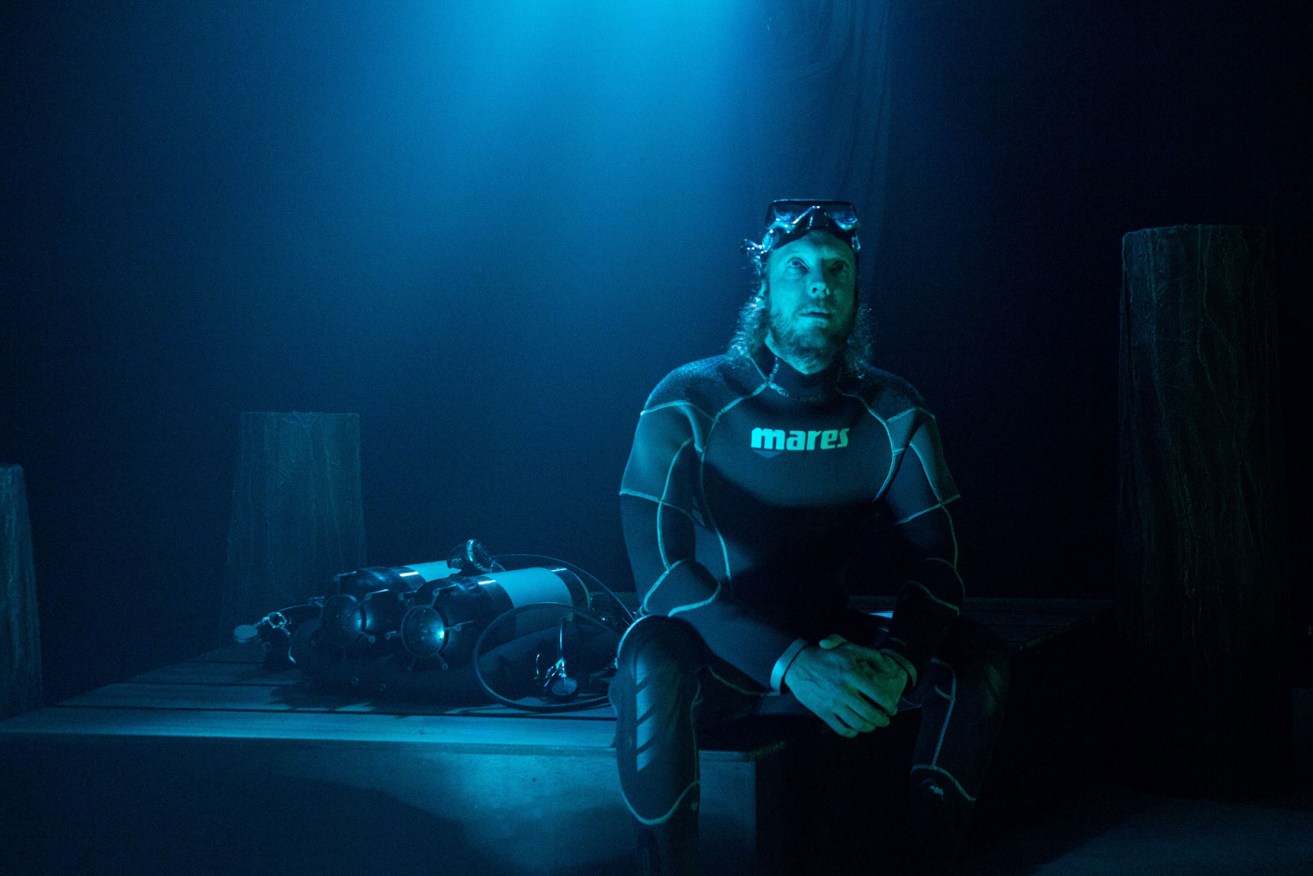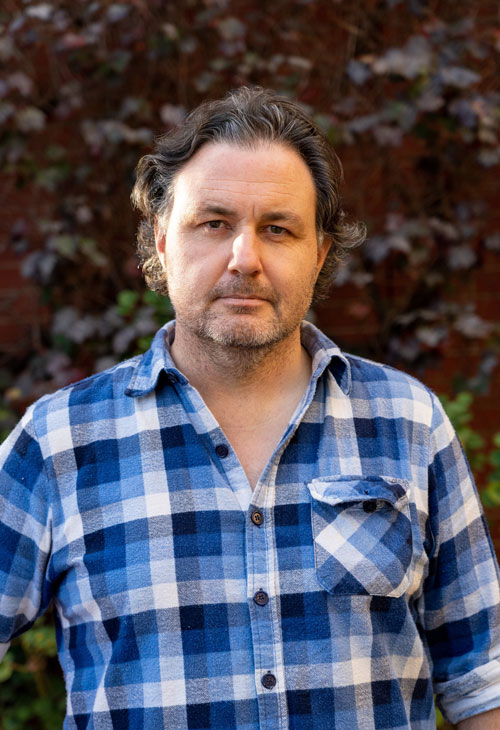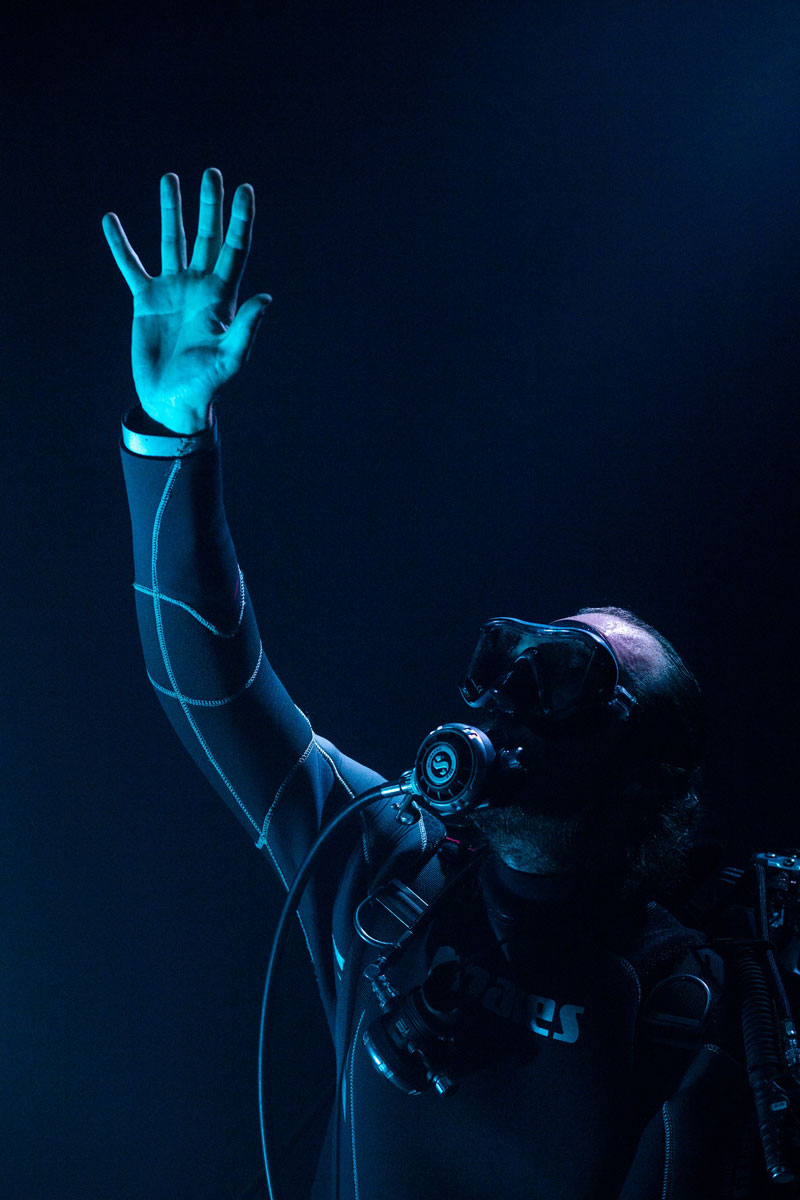Seeking hope in deep waters: Caleb Lewis’s Cathedral
Inspired by South Australia’s Limestone Coast and an experience from his own childhood, Caleb Lewis’s new play is a deep dive into a dark night of the soul.


Nathan O'Keefe plays diver Clay in the State Theatre Company South Australia and Country Arts SA production of 'Cathedral'. Photo: Jessica Zeng
The artistic world post-2020 will inevitably feature many works that deal with the experience of the pandemic. Award-winning, home-grown playwright Caleb Lewis is not particularly interested in this topic. Although he quips that “2020 was a f∗∗ker of a year”, his new one-man play Cathedral, set to premiere in the Space Theatre next week, dives into different territory.
Lewis says the birth of Cathedral – centred around a character named Clay (portrayed by Nathan O’Keefe) lost deep within an underwater cave on South Australia’s Limestone Coast – arose out of a “moment of personal crisis about which stories were mine to tell, and where my voice sat in the theatrical landscape”. The idea for his play gained momentum with a commission by State Theatre Company SA artistic director Mitchell Butel, and the script was completed amid the global pandemic.
Many of Lewis’s previous works, including The Honey Bees and Maggie Stone, arose out of societal issues he wanted to explore. In contrast, Cathedral grew out of his own life and family history, and research into the world of deep-sea diving.

Playwright Caleb Lewis worked for a time as a junior diving instructor.
Lewis’s father was a dive instructor and avid cave diver, and Caleb distinctly recalls a family car trip from Melbourne to Adelaide when he was 10 years old. They stopped at the Limestone Coast’s Piccaninnie Ponds, “a Mecca for cave divers”.
“While we were sitting on the jetty, Dad told us about the numerous divers that have died there, and how many ways there are to die in a cave. Then he said: ‘I’m going for a dive.’
“I remember that hour stretching on for eternity, wondering if he’s going to come back.”
Cathedral, named after one of the famous caves at Piccaninnie Ponds, follows Clay, whose mother is lost while diving. After this, he leaves Mount Gambier to pursue an international life in commercial diving, before eventually returning home.
Seeking absolution about his grief, and facing a personal crisis, Clay decides to dive in the Cathedral, where his mother disappeared. The play opens in the abyssal darkness at the bottom of this sinkhole, with memories, hallucinations and reality blending into one another as nitrogen starts to overpower Clay’s bloodstream.
Lewis has an open-water diving certificate, and for a time worked in Dubai as a junior diving instructor under his father. He even took a course in underwater helicopter escape – essential for oil rig workers – where they “fit you into a helicopter fuselage over a pool, strap you in, and drop you into the water from six metres in the air”.
The playwright has also integrated into Cathedral a compelling story from his grandfather of a similar underwater escape from plane fuselage during night bombing raids over Nazi-occupied Europe. This led to his grandfather being a member of the exclusive Goldfish Club, open only to those who have escaped from aircraft that have crashed into water.
Like astronauts, deep-sea divers venture into a frontier for which our human physiology is not suited. Lewis researched the world of commercial diving extensively and interviewed multiple members of the Cave Diving Association of Australia. Notably, he also spoke to Richard Harris, diver and 2019 Australian of the Year, who was instrumental in the Tham Luang cave rescue.
“I became interested in the sort of people that are drawn to commercial diving… your average cave diver isn’t an athlete nor an ‘alpha’ personality; they’re often quite solitary but are interested in exploring the unknown.”

Photo: Jessica Zeng
In writing Cathedral, Lewis took two trips to Mount Gambier to explore the Limestone Coast and spoke to park rangers and Indigenous elders to learn the significance of cave sites. On the second trip, he was accompanied by Cathedral director Shannon Rush and actor Nathan O’Keefe, and they had the opportunity to dive at Piccaninnie Ponds. Lewis speaks eagerly about the fascinating prehistoric origins of the area: “Limestone is mainly dead aquatic life compacted under the ocean, and as the ocean rolled back you are left with this huge mantle of bone.”
Similar to the Yucatan Peninsula in Mexico, limestone’s extreme porousness led to “great cavities in the landscape”. In Mayan mythology, these were seen as portals to Xibalba (the underworld), and in Cathedral, Clay’s journey to the depths of the underwater cave alludes to Orpheus and Eurydice. The events of the play reflect Clay’s struggle with the risk of being submerged by his grief, and the fight to return to the light and into the future.
During the writing of Cathedral, Lewis suffered family losses due to the COVID pandemic: “I didn’t know it at the time, but a lot of writing Cathedral was about processing that grief.”
Thus, much of the play emerged through a more instinctual writing process, and the structure of the text reflects a more fluid approach to drama, with scenes flowing and bleeding into one another, and echoes of memory informing and sometimes overtaking the present.
Overarching the production in the Space Theatre is an immersive soundscape and visual design created by set and costume designer Kathryn Sproul, lighting/video designer Mark Oakley, and sound designer/composer Andrew Howard that seeks to evoke the unique atmosphere of a deep-sea limestone cave. Pre-recorded voice actors portray the characters that riddle Clay’s mind throughout the play, and O’Keefe is “caught lockstep in a dance between them”.
Asked what he hopes the audience will get out of the play, Lewis says he feels like he’s turned a corner, noting that with much of his earlier work he felt a need to educate for social change. Now, after these last few years of “flood and plague – the apocalypse visiting us one by one – I see the value of escapism that I had not recognised before”.
He also feels the need, having brought the audience down with Clay into the depths of Piccaninnie Ponds’ Cathedral, to bring them back up towards the light. Referencing Conor McPherson, writer of recent State Theatre production The Girl from the North Country, he says: “You can take audiences into a long dark night of the soul, but you have the responsibility to lead them out into the morning.”
State Theatre Company South Australia and Country Arts SA, in association with Flinders University, are presenting Cathedral at the Space Theatre from May 6-21, followed by a regional SA tour taking in Mount Gambier, Port Augusta, Port Lincoln, Renmark, and Port Pirie.
Gianluca Noble is the second recipient of the Helpmann Academy InReview Mentorship. He is working with experienced writers Murray Bramwell (theatre) and Jane Llewellyn (visual arts) to write a series of articles for publication in InReview.




